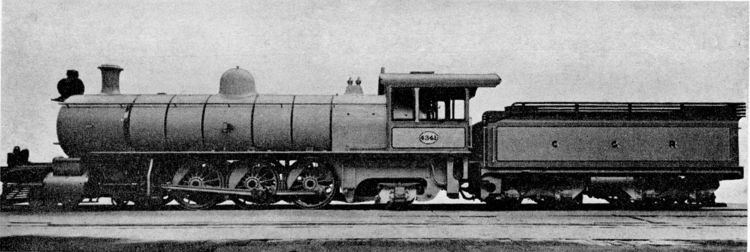Configuration 2-axle bogies | In service 1906 | |
 | ||
Locomotive ♠ CGR 9th Class of 1906♥ CGR 10th Class Gauge 3 ft 6 in (1,067 mm) Cape gauge | ||
The South African type XF2 tender was a steam locomotive tender from the pre-Union era in the Cape of Good Hope.
Contents
Two Type XF2 tenders entered service in 1906, as tenders to the 9th Class 2-8-2 Mikado type and 10th Class 4-8-0 Mastodon type experimental steam locomotives, of which one each were acquired by the Cape Government Railways in that year. The two tenders were not identical.
Manufacturer
Both Type XF2 tenders were built in 1906 by Kitson and Company.
The tenders entered service as tenders to the CGR 9th Class and CGR 10th Class of 1906, both experimental locomotives. The locomotives and tenders were designed by H.M. Beatty, the Chief Locomotive Superintendent of the Cape Government Railways (CGR), at the Salt River works in Cape Town.
Characteristics
The two tenders were not identical. The tender of the 9th Class had a coal capacity of 7 long tons 10 hundredweight (7.6 tonnes) and a maximum axle load of 9 long tons 11 hundredweight (9,703 kilograms), while the tender of the 10th Class had a coal capacity of 10 long tons (10.2 tonnes) and a maximum axle load of 10 long tons 18 hundredweight (11,070 kilograms). Both had a water capacity of 3,000 imperial gallons (13,600 litres).
Locomotives
On the South African Railways (SAR) roster, the two locomotives were designated Classes Experimental 5 and Experimental 6 respectively in 1912. In the SAR years, tenders were numbered for the engines they were delivered with. In most cases, an oval number plate, bearing the engine number and often also the tender type, would be attached to the rear end of the tender. During the classification and renumbering of locomotives onto the SAR roster in 1912, no separate classification and renumbering list was published for tenders, which should have been renumbered according to the locomotive renumbering list.
Only these two experimental locomotives were delivered new with Type XF2 tenders and were renumbered to the SAR numbers as shown.
Classification letters
Since many tender types are interchangeable between different locomotive classes and types, a tender classification system was adopted by the SAR. The first letter of the tender type indicates the classes of engines to which it can be coupled. The "X_" tenders could be used with the following locomotive classes:
The second letter indicates the tender's water capacity. The "_F" tenders had a capacity of 3,000 imperial gallons (13,600 litres; 3,600 US gallons).
A number, when added after the letter code, usually indicates differences between similar tender types, such as function, wheelbase or coal bunker capacity.
